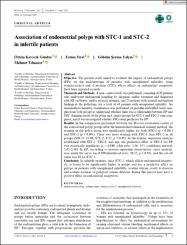| dc.contributor.author | Kayacık Günday, Özlem | |
| dc.contributor.author | Fırat, Fatma | |
| dc.contributor.author | Yalçın, Gülsüm Şeyma | |
| dc.contributor.author | Yılmazer, Mehmet | |
| dc.date.accessioned | 2023-05-12T09:04:20Z | |
| dc.date.available | 2023-05-12T09:04:20Z | |
| dc.date.issued | 2023 | en_US |
| dc.identifier.citation | Kayacık Günday, Ö., Fırat, F., Yalçın, G. Ş., & Yılmazer, M. Association of endometrial polyps with STC‐1 and STC‐2 in infertile patients. Journal of Obstetrics and Gynaecology Research. | en_US |
| dc.identifier.issn | 1447-0756 | |
| dc.identifier.uri | https://dx.doi.org/10.1111/jog.15658. | |
| dc.identifier.uri | https://hdl.handle.net/20.500.12933/1528 | |
| dc.description.abstract | Objective: The present study aimed to evaluate the impact of endometrial polyps (EPs) on the endometrium of patients with unexplained infertility using stanniocalcin-1 and -2 proteins (STC), whose effects on endometrial receptivity have been reported recently.
Materials and methods: A case-control study was performed, consisting of 26 patients who underwent endometrial sampling for diagnosis and/or treatment and diagnosed with EP on biopsy and/or excision material, and 23 patients with normal endometrial findings in the pathology, for a total of 49 patients with unexplained infertility. An immunohistochemistry examination was performed on paraffin-embedded tissue samples from both groups to understand whether there was a relationship between EP and STC. Staining results of the polyp and control groups for STC-1 and STC-2 were compared, and it was investigated whether STCs were predictive for EP.
Results: In the comparison performed between the H-score evaluation results of the control and polyp groups after the immunohistochemical staining method, the staining in the polyp group was significantly higher for both STC-1 (p < 0.001) and STC-2 (p < 0.001). There was more staining with STC-1 than STC-2 in all groups (STC-1: 15.08; STC-2: 8.27; p < 0.05). In the logistic regression analysis established with STC-1, STC-2, and age, the predictive effect of STC-1 for EP was statistically significant (p = 0.040; odds ratio: 1.66; 95% confidence interval: 1.02-2.68). In EP, according to receiver operating characteristic curve analysis, area under the curve was 0.980 (likelihood ratio: 20.35; p < 0.05), and the cut-off value was 18 for STC-1.
Conclusion: In infertile patients, since STC-1, which affects endometrial receptivity, is found to be significantly higher in polyps and has a predictive effect on polyps, in patients with unexplained infertility, routine uterine cavity evaluation and routine excision of polypoid lesions detected during this period may have a positive effect on endometrial receptivity. | en_US |
| dc.language.iso | eng | en_US |
| dc.publisher | Wiley on behalf of the Japan Society of Obstetrics and Gynecology | en_US |
| dc.relation.isversionof | 10.1111/jog.15658. | en_US |
| dc.rights | info:eu-repo/semantics/embargoedAccess | en_US |
| dc.subject | Endometrial Polyps | en_US |
| dc.subject | Polypectomy | en_US |
| dc.subject | Stanniocalcin-1 | en_US |
| dc.subject | Unexplained İnfertility | en_US |
| dc.title | Association of endometrial polyps with STC-1 and STC-2 in infertile patients | en_US |
| dc.type | article | en_US |
| dc.authorid | 0000-0002-9249-679X | en_US |
| dc.department | AFSÜ, Tıp Fakültesi, Cerrahi Tıp Bilimleri Bölümü, Kadın Hastalıkları ve Doğum Ana Bilim Dalı | en_US |
| dc.contributor.institutionauthor | Kayacık Günday, Özlem | |
| dc.contributor.institutionauthor | Fırat, Fatma | |
| dc.contributor.institutionauthor | Yalçın, Gülsüm Şeyma | |
| dc.contributor.institutionauthor | Yılmazer, Mehmet | |
| dc.relation.journal | The journal of obstetrics and gynaecology research | en_US |
| dc.relation.publicationcategory | Makale - Ulusal Hakemli Dergi - Kurum Öğretim Elemanı | en_US |
















